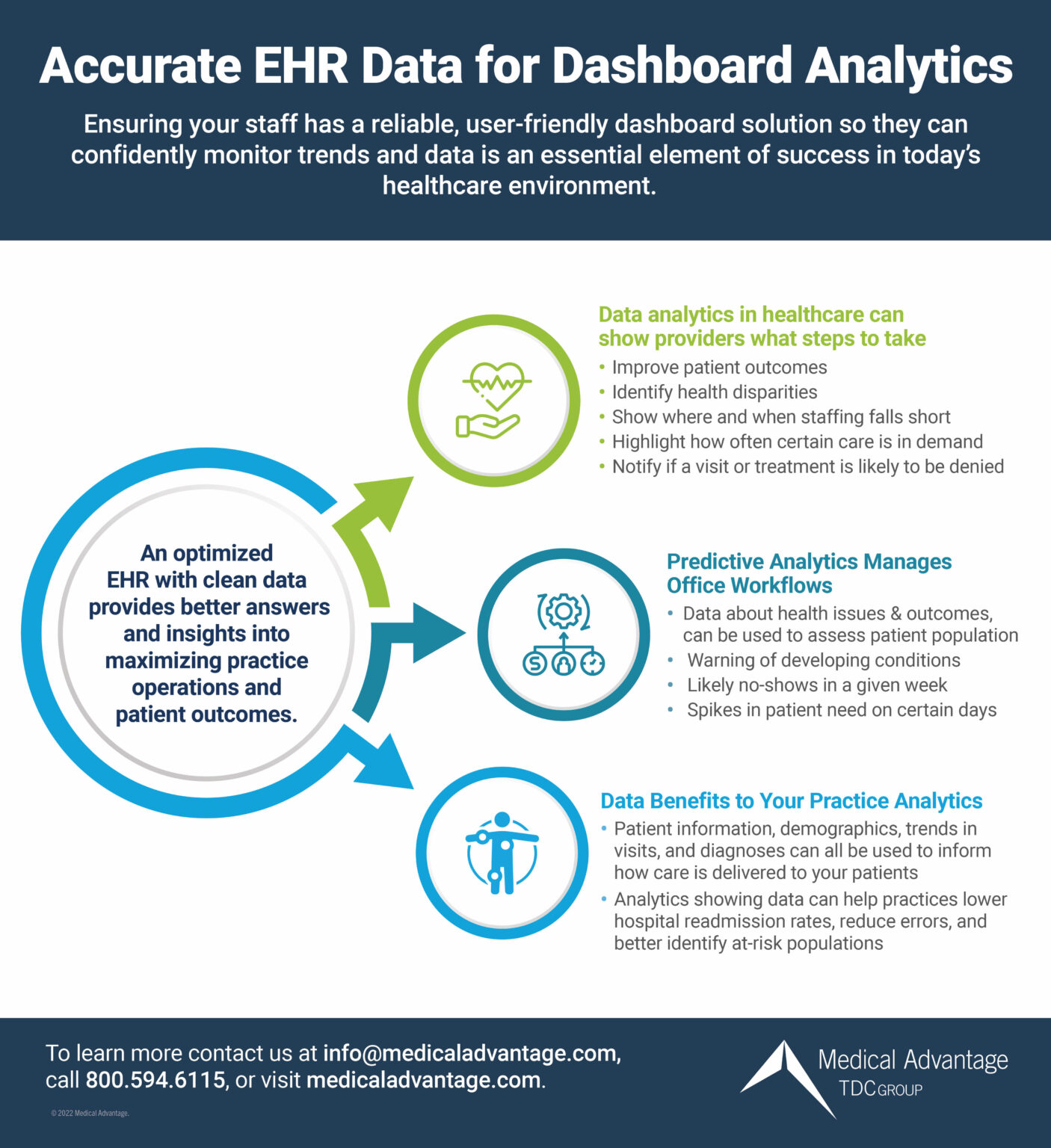Your practice’s electronic health records (EHR) system provides the raw, unprocessed data you will need to leverage healthcare analytics to your advantage. An optimized EHR with clean data will provide better answers to your business questions and offer you better insights and opportunities for maximizing practice operations and patient outcomes.
Practices of every size and specialty can benefit from the data provided by EHRs (Electronic Health Records) and other practice data sources – especially when organized into a thoughtful dashboard that combines your disparate data sources into one easy-to-use executive healthcare data dashboard. Optimizing your data analytics using EHR in healthcare provides timely, secure, verified, and accurate data collected directly from your practice to make the key business decisions to make your practice thrive.
How Is Data Analytics Being Used in Healthcare?
Developments in healthcare data analytics (including EHR data) have revolutionized the healthcare industry over the last few decades, providing the pathway for measurable improvements in patient outcomes, practice operations, physician productivity and reimbursement.
Studying EHR data helps providers determine what steps to take to improve patient outcomes, according to Health IT Analytics reports. Data analytics improves providers’ ability to identify health disparities in medical records and other patient data with risk modeling that addresses gaps in patient care. Emerging artificial intelligence (healthcare AI) can even help identify at-risk patients who do not appear to have any risk factors.
Practice operations benefit from data analytics when the insights gathered from data are used to make positive change (also referred to as operational analytics). Operational analytics highlight where and when staffing is coming up short throughout the week, how often certain types of care are in demand, or if a particular visit or treatment claim is likely to be denied so you can take action to improve practice operations.
EHR data in prediction models can also provide guidance in preventing suicide among patient populations, as shown in a 2018 study published in the American Journal of Psychiatry. The study concluded that prediction models using health record data combined with responses to self-report questionnaires outperformed any existing suicide risk prediction tools.
How Elements of Your EHR Data Can Benefit Your Practice Analytics
Patient information, demographics, trends in visits, and diagnoses can all be used to inform how care is delivered to your patients, and your data analytics using EHR in healthcare powers your practice’s analytics in guiding your decision-making.
Patient information such as blood sugar level, temperature, blood test results, and even the patient’s wishes can help medical practices lower hospital readmission rates, reduce errors, and better identify at-risk populations.
Demographic information can help show whether a specific group is experiencing health disparities. Information about the number of visits can inform whether a patient is likely to require more resources or if they will need to be reminded to keep appointments and follow up on routine screenings.
Using Predictive Analytics to Manage Office Workflows
Predictive analytics uses data about past patients (including health issues and outcomes), to assess your patient population for warning signs for conditions that are about to occur, allowing your staff to take preventive measures and to have adequate staff in place in anticipation of medical problems.
Medical offices experience many trends and data analytics using EHRs can be used to predict these trends and maximize practice staffing and productivity accordingly. Office workflows can also benefit from analytics showing the number of no-shows on a given part of a particular month, for instance, allowing staff to focus efforts on reminders for patients when analytics show a spike in missed appointments is likely on the horizon. A medical practice may also offer those patients who are likely to be no-shows transportation services that will aid them in making their office appointments.
Predictive analytics and EHRs were also demonstrated as useful in eliminating wasted time spent on a physician’s EHR inbox management in a January 2022 study published in The American Journal of Managed Care.
EHR inbox work – opening, reading, and, answering email – comprises about 25 percent of a provider’s time, taken up by administrative matters that are not patient-related, HIPPA-covered matters. An analysis of inbox traffic showed a data-driven methodology to identify the work themes managed by each PCP (primary care physician) was possible. The information allowed a “redesign of workflow processes to eliminate unnecessary workload on PCPs and improve cost and quality of care,” the study concluded.
Using Healthcare Dashboards for Streamlined EHR Analytics
Your time is best spent thinking about how to act on data rather than trying to make sense of it through processing. Data analytics using EHR in healthcare creates the foundation for the clues you will need to solve challenges with practice workflows, anticipate mental health interventions and deliver patient care even when it is in high demand. Dashboards organize and present that data in an easily read and interactive format, accelerating your ability to put plans in place that saves time, work, and stress for both you and your patient community.
Dashboards can be customized for any application, so if a novel problem presents itself, a savvy dashboard expert can deliver a quick solution.
Dashboards allow experienced users to explore the details of your patient demographics, which types of care are most in-demand, the types of claims submitted, and how often claims are denied as well as the reasons for denials. Any metrics we have discussed in this article could be added to a dashboard view. Dashboards also allow these measures to be compared to other data, such as hospital admissions, specialty care referrals, or costs by service time and practice revenue.

Setting Up for Success with Continued Simple Analytics
EHRs can be tricky to set up and extract data from, and the data analysis of that information can also pose a complicated challenge. Ensuring your staff has a reliable, user-friendly dashboard solution so they can confidently monitor trends and data is an essential element of success in today’s healthcare environment.
The right dashboard solution will not only help you visualize key aspects of your practice, but it will also be easily adjusted to provide unforeseen insight into the elements of your practice that are posing issues or driving your success.
Using Healthcare Dashboards for Streamlined EHR Analytics
Streamlined EHR analytics using healthcare dashboards presents the key metrics that help you make the most sense as you plan for your practice’s success. For this reason, your healthcare dashboards should organize and present your data in a clear manner, allowing you to interpret and implement insights gleaned from the data to realize your vision of success.
Medical Advantage Can Help
Dashboards – like the ones built by the experienced healthcare experts at Medical Advantage – enable practices to optimize workflows, health outcomes, and boost staff satisfaction. Read on to see which of our healthcare dashboard solutions is right for you.





